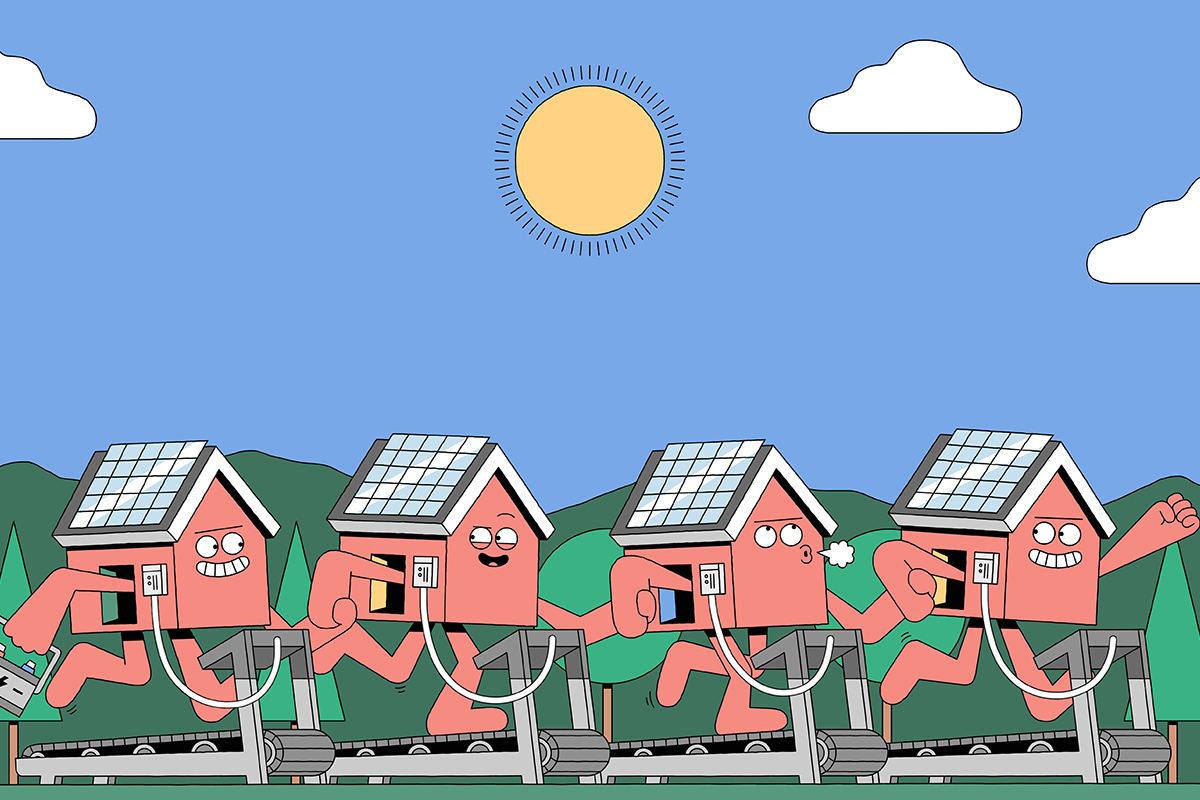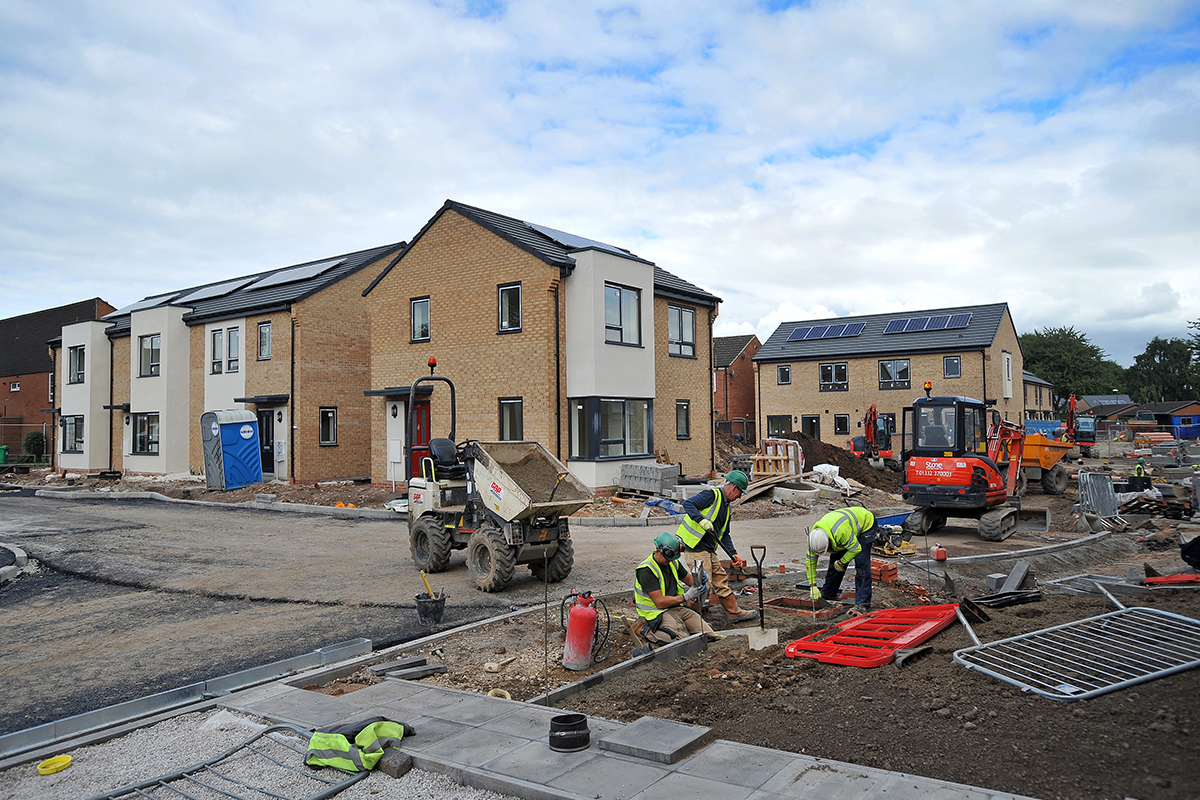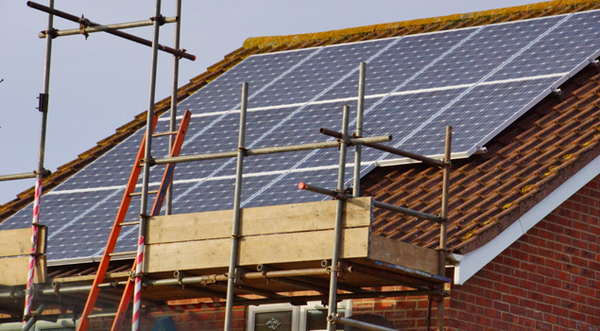You are viewing 1 of your 1 free articles
The homes that generate energy
A small energy generation scheme in a Welsh town could make a big difference to its tenants and the wider environment. Nathaniel Barker finds out what’s been happening in the Valleys. Illustration by Dan Woodger
In a quiet corner of South West Wales, a small technological revolution is taking shape.
Pobl, the country’s largest social landlord with around 15,000 homes, has received planning permission to build the sector’s first ‘power station homes’.
There will be 16 of them – eight houses and eight flats – perched on the site of an old care home in the town of Neath, all available for social rent.
Using photovoltaic panels on their walls and roof, the buildings will capture electricity, while a solar heat collector on south-facing walls will provide water heating. Crucially, shared batteries will hold on to the electricity until it is needed. Any waste heat is then trapped and recycled back into the building, supplemented by a heat pump.
In this way, the homes will be able to generate and store their own energy for later use – just like mini power stations. None of the technology is new in isolation, but it will be the first time it has all been put together to create housing of this kind.
Elfed Roberts, head of projects at Pobl, says the small scheme is part of “a learning process” for the landlord, that wants to be able to replicate it at scale. “We are very excited about it,” he says. “We want to learn from it so that we can try and do this as a norm in the future.”
Generating savings
For tenants, the potential benefits are huge. A report on the scheme estimates that the model could cut energy bills by more than 60% – saving the average household upwards of £600 a year. That is a big deal in Wales, where 23% of households are in fuel poverty.
“The person living in the property will have a grid connection but for eight months of the year you’re not going to need it,” says Mr Roberts. “That money they save will help offset service charges or be a fund to help them pay for the rent.”
For the landlord, this in turn goes some way to alleviate nagging fears about spiralling levels of arrears as Universal Credit and the Local Housing Allowance cap take hold.
And then there are the positive environmental impacts if this type of building were adopted on a wider scale. Energy consultant Andris Bankovskis, who wrote the aforementioned report and also sits on the government’s Electricity Market Reform Panel of Technical Experts, has his eyes fixed on the bigger picture.
“My objective was to look at what would happen if this was adopted at a level big enough to make a real difference and what the effects on the whole system would be,” he explains.
His answer: that carbon dioxide emissions would be reduced by nearly 80 million tonnes over 40 years and there would be a decrease in peak generating capacity of around 3,000 megawatts – roughly the equivalent of a nuclear power station being added to the National Grid.
Plugging away
The technology for the scheme – Active Homes Neath, as Pobl calls it – was developed by Specific, a consortium of academics and industry experts at Swansea University tasked with getting renewable energy projects off the ground.
Specific kick-started its ‘buildings as power stations’ work in 2014 with ‘The Pod’. This used similar technology to the Neath scheme, but it was only a little more substantial than a garden shed, and is now used as a car park attendants’ cabin. Then, in October 2016, the company completed the Active Classroom project on Swansea University campus, fully scaling up the system. Data is currently being collected on how the building is performing.
“Our specific remit is to help showcase these technologies, to do this initial testing,” says Janet Bell, commercial director at Specific. “The big challenge is: how do we get developers on board?”
“This is not a project where we are getting a red carpet rolled out for us.”
Jonny Williams, the consortium’s project manager for the scheme, adds: “Social housing is a really good market for this technology. The developer rents out the property forever, so you can take a whole-life cost approach to it.”
Pobl, which has now received planning permission for the development in Neath, is in the process of putting its contracts out to tender. It hopes to get its usual builders on board, according to Mr Roberts, and to have the homes coming out of the ground by March next year, with an estimated construction period of 12 months.
But the housing association is something of a special case in this instance. It has benefited from collaboration with Neath Port Talbot Council as part of the Swansea Bay City Deal, a £1.3bn investment programme in the region signed off by prime minister Theresa May in March. Under this deal, local housing providers have the option of funding for a further 1,200 units if the initial project is successful. What’s more, Pobl’s costs will be topped up by funding secured through the Welsh Government’s £20m innovative homes programme.
“We need things like the Wales innovative housing fund to really focus people’s minds,” says Ms Bell. Across the River Severn in England, no direct funding for technologically adventurous schemes is currently available from the Homes and Communities Agency.
The Pobl scheme will not be fully costed until the end of October. Specific reckons its Active Classroom was around 20% more expensive than a normal build of equivalent size, though Mr Williams hopes that margin will be smaller this time around.
Some would-be punters might well be put off by the higher initial price tag of power station homes, but Ms Bell insists “a number of other” landlords have expressed interest, from beyond the Welsh borders. And, she adds, Specific has been in talks with “some of the major providers” of offsite manufacturing.
In any case, it will be a while yet before this model is rolled out across the wider sector, according to Amy Simmons, head of policy at the National Housing Federation.
“It’s an interesting one to watch. I think one of the issues with things like this when you have lots of different types of technology is how residents respond to them. You would want to see how those homes are built and how they perform over a year,” she says. “The biggest risk if you’re an early adopter is you maybe don’t make as many savings as you potentially thought. It feels like it’s part of a longer-term picture.”
Up to the challenge
For those who do follow in Pobl’s footsteps, obstacles will doubtless present themselves.
“People will object to these homes for planning reasons and things like that, or builders just won’t go in for it. I know people who just don’t want to install it,” says Richard Lupo, senior sustainability consultant at Sustainable Homes.
“You’ve just got to remember these homes are for living in and need to be comfortable and aesthetically acceptable. I’m sure it’s totally doable.”
Mr Bankovskis admits that his vision of a million power station homes “would be a very big challenge”.
“I’m sure contractors will come up with many issues. The lack of an established supply chain, for example.”
Then there’s the question of whether this technology will still be relevant by 2019 – when the homes will have been in place long enough to prove themselves. Electricity storage is still in its infancy and the Neath scheme’s battery method could soon be superseded, Mr Lupo explains. For instance, large, centralised cryogenic storage plants could suck away funding – with the world’s largest facility currently being commissioned near Manchester.
But, as Mr Roberts points out, pioneering an attempt to make any meaningful change to the way homes use energy is never going to be easy. “This is not a project where we are getting a red carpet rolled out for us,” says Mr Roberts. “There are going to be challenges.”
For Pobl, and for Mr Bankovskis, the project is still worth pursuing. “Those challenges lead to very large benefits,” he says.
Like with so much else, real progress on a wider scale can only be made when central government starts to take notice and pave the way for the technology to become more investable. As Mr Bankovskis remarks in the conclusion of his report, “every aspect of the electricity market is created by the hand of government intervention”.
Current policy includes few incentives for these sorts of projects, particularly after the withdrawal of the Green Deal and the Code for Sustainable Homes, so it’s unlikely we’ll see power station homes on streets across the country any time soon. Until then, Pobl hopes the sun shines in the Valleys.











